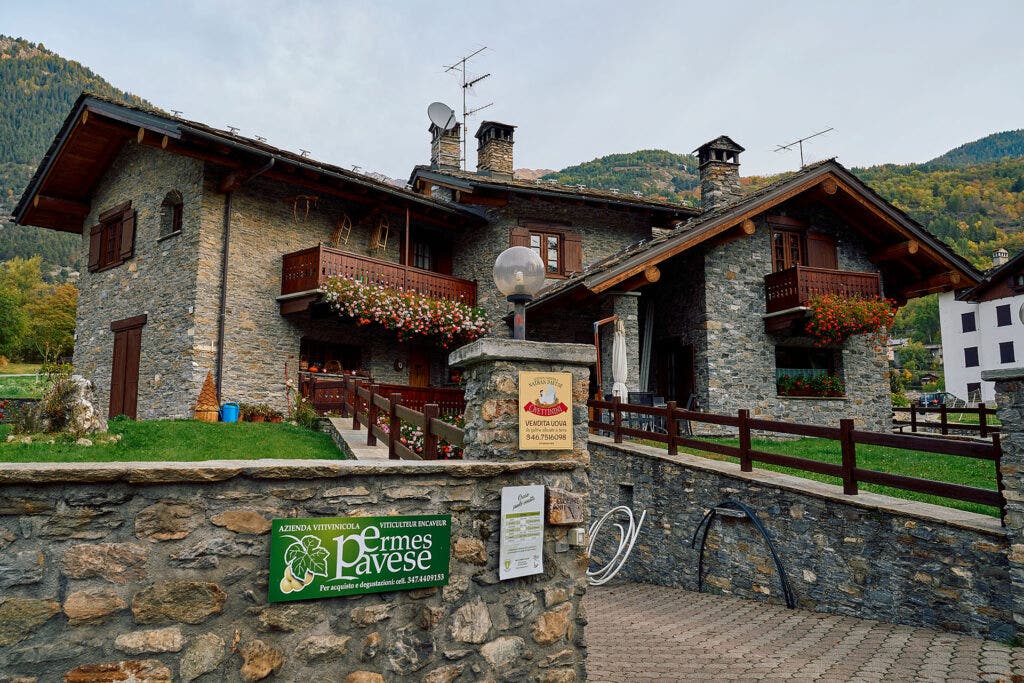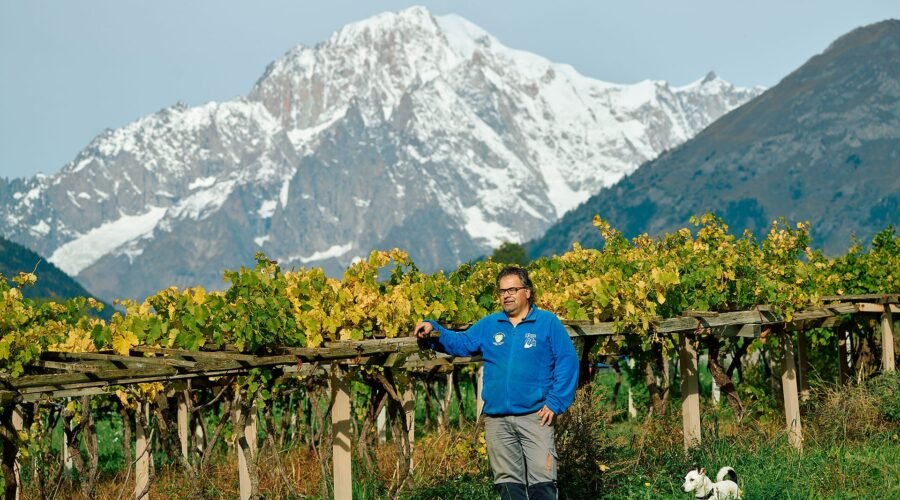Culture: In Europe’s Highest Vineyards, the Little-Known Prié Blanc Grape Takes Flight
“Wind makes different grapes, and different grapes make different wine,” Ermes Pavese says. Where most winemakers might lead with soil, Pavese mentions wind. He’s not talking about gentle gusts or the soft sea breezes like winemakers in other parts of Italy might. Little is gentle at nearly 4,000 feet above sea level on the south-facing slopes east of Courmayeur, on the Italian side of Mont Blanc. Relatively new to winemaking and working with some of Europe’s oldest rootstock, the 49-year-old Ermes Pavese knows a thing or two about the quickly changing weather and cutting rays of sun on the serrated peaks surrounding northern Italy’s Valle d’Aosta. Along with his son, Nathan, and daughter, Ninive, both still in their 20s, Pavese’s three-person wine operation wrestles a little-known white grape, Prié Blanc, into bottles of wonderfully racy and mineral driven Blanc de Morgex et de La Salle.
Peek into a few wine shops that boast bottles from micro-producers and you are bound to come across the squat, playfully labeled bottles of Pavese’s Blanc de Morgex et de La Salle. In recent years, it’s become known as a deliciously cheerful, easily accessible, white wine with loads of acid—all made possible by a far-flung Alpine microclimate. Blanc de Morgex et de La Salle DOC is made with 100% Prié Blanc, a grape planted on less than 30 hectares total in all the Valle d’Aosta. Ermes Pavese produces about 40,000 bottles of it from 7.5 hectares etched into Mont Blanc. These are the highest elevation vineyards in Europe, and Pavese’s view from here is expansive in more ways than one. “I want to make wine with only Prié Blanc and send it out to the rest of the world,” he says.
The rest of the world seems far away from the Valle d’Aosta, Italy’s smallest region—tucked into the county’s northwestern corner and hidden by mountains that create borders with both France and Switzerland. The region’s dramatic landscape does provide a picturesque, albeit challenging, backdrop for winemaking, especially when compared to the dulcet rolling hills of its southern neighbor, the Piedmont—a region packed full of world-renowned wineries. While the region represents the country’s smallest appellation, with roughly 400 hectares of vineyards, some of its rootstock is the oldest: The high altitude and low temperatures provided protection from phylloxera, a root louse that wiped out most of Europe’s wine production at the end of the 19th century. Quite a few grapes are grown in Valle d’Aosta DOC, including Pinot Noir, Petite Arvine and Nebbiolo (locally called Picotendro). There are 11 surviving indigenous red grapes in the region, including Fumin, Petit Rouge, Roussin de Morgex, Cornalin and a single white—Prié Blanc.
Relatively Recent History
Despite Italy’s tradition of winemaking reaching back millennia, you will uncover very little documented history for Prié Blanc. What we do know is that it’s grown in limited areas—mostly the Valle d’Aosta and a bit in the Valais region of Switzerland—with limited yield. And, until Pavese’s releases, with limited interest outside the region. The first recorded mention of the grape dates to a late 17th-century public record of grapes grown around the town of Saint Pierre in the Aosta Valley. But, one has to imagine that timeline has less do with the actual growing history of the grape, and more to do with the documentation—especially in a part of the world where the Renaissance is relatively recent history. It seems most of the grape’s story is that of a blending grape and a table wine that didn’t make it beyond the immediate mountainous terrain.
Being at the mercy of the weather is the life of any winemaker, but at 4,000 feet things are different.
Ermes Pavese
Ermes Pavese’s laser focus on Prié Blanc drives his eponymous winemaking operation in the hamlet of La Ruine, located between the two towns of Morgex and La Salle that make up a small subregion of the larger DOC, hence the name Blanc de Morgex et de La Salle. It should be noted that Italian and French are used interchangeably in this area, especially on wine labels. Here, a string of tiny villages runs alongside the Dora Baltea, a charging celadon river that originates from glacial springs on Mont Blanc, running southeast through the region—ultimately feeding into the Po River northeast of Turin. Pavese’s vineyards are just north of Morgex. Where neighboring vineyards rub against the base of the mountains, Pavese’s climb upward on step terraces—made possible by an extensive network of dry-stone walls, which appear as a feat of ancient engineering and the result of a tremendous amount of labor. The vines are grown on a pergola bassa, or low pergola, system, where they are trained to umbrella over raised canopies of wooden lattice supported by stone plinths and columns. The pergola system allows the leaves of the vines to shield the hanging grapes from high winds and rain (sometimes hail), while providing shade from direct sun. Being at the mercy of the weather is the life of any winemaker, but at 4,000 feet things are different, and pergolas can only help so much. The plummeting temperatures often demand Pavese is harvesting at a time when most European vineyards are basking in late summer sun. “Mornings in September can be 0° [Celsius] here, which is too cold. But at least phylloxera can’t survive that,” Pavese laughs, as he talks about the pergolas in his vineyards. “In 2017 we had a frost that killed 99% of our crop. It was devastating. So, we made wine from what was left, and called it Uno Percento: Anno del Grande Gello,” or One Percent: Year of the Great Frost, “a production of 999 bottles of skin-contact, orange wine, aged in cement.”
His winery is on the ground floor of a modest gray stone building with a heavy slate roof. It is mostly indistinguishable from the alpine homes in the hamlet and features a family residence on the second floor. “This operation started from 2 hectares of family vineyards,” Pavese explains. “Originally more of a family hobby you could say. I committed to making it a business in the late 1990s, after I was encouraged to do so by my uncle Carlo.”
Pavese’s Blanc de Morgex et de La Salle shows this commitment, and makes up a significant portion of his production, usually about 25,000 bottles. Prié Blanc is macerated 24 to 48 hours and aged in stainless steel tanks up to a year. The wine is straw-yellow and mineral driven from the sandy glacial sediment in the soil. Its acid is racy, and yet it delivers interesting alpine floral notes and an unexpectedly long finish on the palate.

Blanc Slate
The jewel of Pavese’s Blanc de Morgex et de La Salle is “Le Sette Scalinate,” or The Seven Steps. This is Pavese’s single-vineyard cru, made from the oldest family vines, originally cared for by his uncle Carlo, to whom the wine is dedicated. The just under a hectare of remote 100-year-old vines of the Le Sette Scalinate vineyard sees direct sun and is reachable only by seven distinctive stone steps projecting from the terrace wall. Its first release was 2010, and this wine is easily the purest expression of Prié Blanc available.
Pavese also makes sparkling wines from Prié Blanc, both a pét-nat and a traditional method (non-dosage). At the moment he’s trying versions with 18, 24, 36 and 38 months of lees aging. He’s also been experimenting with malolactic conversion in his wines, which changes the need for sulfites, but tames the acid in the Prié Blanc. “The acid is important; I don’t want to lose too much of that,” he adds.
Joe Campanale, sommelier, restaurateur and author of Vino: The Essential Guide to Real Italian Wine, says of Pavese, “It’s great to see a winemaker champion a lesser-known grape. It’s also worthwhile work … in the way that people save heritage seeds for future generations.” But for Pavese, Prié Blanc is both tradition and a blank canvas.

“Eseme” is a Pavese release of Prié Blanc aged for 24 months on the skins in ceramic vessels, similar to amphora. “When my son, Nathan, was a child he called me Eseme because he couldn’t say Ermes; it became sort of an accidental nickname,” he says. “This ceramic is neutral like steel but allows much more oxygen contact with the wine because it’s porous.” Certainly, skin contact and oxygen-rich aging are on-trend right now, and Pavese is on his third vintage of “Eseme,” producing only 500 liters (about 130 gallons) a year. “It was an experiment. It’s still ongoing.”
Ermes’ son, Nathan, is currently making a wine called “Nathan” that takes Prié Blanc in a different direction by aging it in wood. His wine sees 48 hours of maceration and ages in 3- to 5-year-old French oak barriques for 12 months. This version of Prié Blanc is wildly different as the acid mellows so much that it tastes lush and woody, something more akin to American white wines. “Pavese’s really dedicated to seeing what Prié Blanc can do,” Campanale says, adding his, “Blanc de Morgex et de La Salle has much more than acid going on, too—it’s really not uncommon for me to see off-duty sommeliers ordering that wine in my restaurants.”

/ Photography by John McDermott
It’s no surprise that Pavese also produces an ice wine, given the weather in Valle d’Aosta. A cuvée made from grapes harvested after the first real frost (often early December), “Ninive” is named after his daughter, and drinks quite differently from a typical ice wine. It shows acidity and minerality even with the concentrated sugars in the late harvest grapes, allowing herbs and citrus to shine through, although the sweetness emerges more as it ages more in bottle.
Here in Valle D’Aosta, Ermes Pavese is building something new from something very old, without any hang-ups from the past. There is a certain freedom to showing the many sides of the same grape— albeit a grape grown against the odds, in a remote location battered by wind and cold, in extremely limited quantities. He’s cultivating a new parcel, at an even higher elevation: “I want to make a new cru, single-vineyard wine, like Le Sette Scalinate,” says Pavese. “If you stop experimenting, you stay in the past.”
This article originally appeared in the August/September 2023 issue of Wine Enthusiast magazine. Click here to subscribe today!
Published: August 24, 2023
Like what you’re reading? Learn more about:


